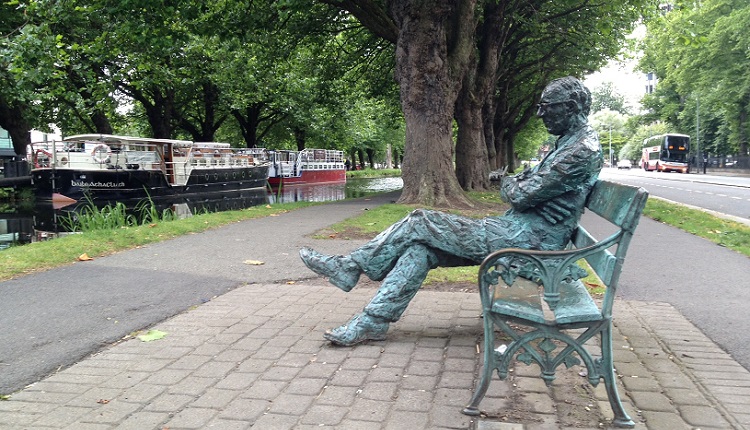The Ploughman and his Poem | Patrick Kavanagh’s ‘Raglan Road’
Fifty years ago, Patrick Kavanagh died on the 30th of November 1967. He was known to be a cantankerous auld codger but from his pen flowed some warmth in the form of his poetry, and one of his most famous pieces can be found on the pantheon of great Irish love ballads.
‘Raglan Road’ entered this world on the pages of The Irish Press on October 3rd 1946. Kavanagh’s poem failed to ignite any plaudits when first published but today it is considered one of the finest pieces of poetry to come out of 20th century Ireland.
The road which Kavanagh wrote about is situated in Ballsbridge, Dublin 4 and was named after Lord Raglan, an English commander during the Crimean War who resided there. Today it is one of Ireland’s most sought after addresses but during Kavanagh’s time it was where he first saw his muse Hilda Moriarty.
When first published, it was titled ‘Dark Haired Miriam Ran Away.’ The Miriam in question was a girlfriend of Kavanagh’s brother and the wily poet chose her name instead of Hilda’s just to avoid embarrassment for himself.
Hilda, from County Kerry, was a 22 year old medical student at the time and the girl from the kingdom captured the heart of the then 40 year old Kavanagh who first spotted her walking down Raglan Road in the Autumn of 1944.
https://youtu.be/gYJO5fJgNSQ
The pair struck up a friendship but Kavanagh wanted more. Hilda relished in befriending poets, artists and writers and teased Kavanagh for writing poems about cabbages and parsnips so she challenged him to write a poem far from the stony grey soil of Monaghan. Kavanagh took up the challenge and the result was Raglan Road.
Kavanagh was besotted with Hilda, he even acquired a painting of the Kerry beauty which he had propped on top of the mantle piece in his dwelling on Dublin’s Pembroke Road. In a 1987 RTE documentary called Gentle Tiger, Hilda stated how any would-be relationship with Kavanagh could not have worked because of the age gap.
In today’s world we would call it a form of stalking but back in the more innocent times of 1940s Ireland, Kavanagh’s infatuation with Hilda led him to following her to Kerry in the Christmas of ’44. Hilda’s family, most notably her father Dr Paddy Moriarty, were not impressed by the bedraggled looking ploughman who was much too old for their daughter and much too light in pocket. An invite to stay in the Moriarty household was not extended to Kavanagh and he spent the festive period in Kruger’s guesthouse outside Dingle.
It was the first time in his life Kavanagh did not spend Christmas at home with his mother but, while he was staying at the guest house of Maurice Kruger in Dunquin he put his talent to some use and wrote an article for the Irish Press called ‘My Christmas in Kerry.’ In it he detailed how the unlicensed premises he was staying in had no problem selling booze on Christmas Day. Kavanagh’s host saw this article as a breach in trust and to rub salt in Kruger’s wound, Kavanagh took his bicycle without asking and cycled to the train station to catch the train back to the capital. Years later when Kruger was applying for a liquor license the judge recalled Kavanagh’s Irish Press article from Christmas ’44 but Kruger assured the judge that the author of the ‘fictitious’ article was nothing more than a vagabond bike thief from up the country.
When ‘Raglan Road’ was first published, it was accompanied with a photo of its creator wearing a jacket two sizes too big while his thinning hair was all unkempt on top of his stern head.
Along with the change in the title, another change from the original Raglan Road is the line “synthetic sights and fish dim eyes, and all deaths loud display” which is now the famous line “the queen of hearts still making tarts and I not making hay.”

‘Raglan Road’ made a second appearance in print when it was published in Kavanagh’s Collected Poems in 1964 and was described as a song lyric. From the moment Kavanagh put pen to paper the Monaghan man had a song in mind. For years after writing it he was known to pass it on to people with fine singing voices in the hope it would become a popular song but it wasn’t until one night in the Bailey bar in Dublin city did ‘Raglan Road’ find the perfect voice to deliver it.
It was on a typical stout soaked night in The Bailey in 1966 when Kavanagh approached Luke Kelly who was at the other end of the bar and asked him to sing a little piece he had written in the ’40s. Kavanagh who was brimming with whiskey informed the Dubliners singer that Raglan Road is suited to the tune of ‘Fainne Geal an Lae’, an old lament from the 1800s, and when Luke Kelly agreed to sing it for the masses that was it, ‘Raglan Road’ was from then on an institution in the Irish song book.
But what of that queen of hearts? Hilda went on to become a doctor and married Fianna Fail Minister Donogh O’Malley but, she never forgot the ploughman poet. When Patrick Kavanagh was laid to rest in his stony grey soil of Monaghan in November ’67 Hilda sent a wreath of red roses in the shape of the letter H.
